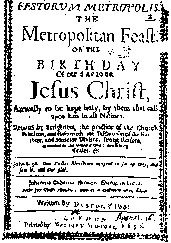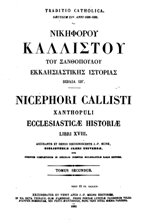The Enrollment of Cyrenius
Editor's note: This page contains two pieces regarding the enrollment of Quirinius, one, a paragraph from the Orthodox Churchman’s Magazine for July thru December, 1802 (Vol. III, London, 1805, pp. 73, 74), the other adapted from Finegan’s Handbook of Biblical Chronology. As these pieces show, the present state of our information about the census and sucession of Roman governors and procurators is far from perfect. Even so, both articles demonstrate that the “taxing,” “census,” or “enrollment” occurred in 3-2 B.C., precisely in keeping with Luke’s chronology regarding the blessed Savior’s birth.
___________
A Critique on Psalm II
The Orthodox Churchman’s Magazine and Review
London, 1802
Excerpts from
The word, οικουμενη, was anciently used in the limited sense of “inhabited;” thus Canaan, is styled οικουμενη as distinguished from the wilderness. Exod. 16, 35. and also by a first rate classical authority, Xenophon: οικουμενηn κωρα “an inhabited country” distinguished from ερημη “a desert.”
“That all inhabited [land] should be enrolled,” Luke 2, 1. – Meaning Herod the Great’s dominions of Judea and Galilee; with whom the emperor had been offended for redressing himself by force of arms, in a quarrel with Syllaeus, a neighbouring prince, without the emperor’s permission; - At that time, the decree proceeded no further than the enrollment of persons; by Cyrenius (or Quirinius) the emperor’s procurator (as we learn from Justin Martyr) or commissioner of his revenues, in the imperial provinces; acting under Saturninus, president of Syria; (as we learn from Tertullian). Herod having contrived to appease the emperor’s anger: Nor did the assessment of incomes (επιτιμησις) take place till ten years after the death of Herod, when Archelaus his son was deposed, on the complaint of the Jews and Samaritans; and the trusty Cyrenius sent again in quality of president of Syria; to complete the Census, and enforce or levy the capitation tax: as we learn from Josephus, Tacitus, and Luke 2, 2. αυτη η απογραφη πρωτη εγεςετο ηγεμονευοντος της Συριας Κυρηνις –“the taxing itself, was first made, while Cyrenius was president of Syria” and not without considerable opposition indeed on the part of the Pharisees, and of the insurgents under “Judas of Galilee, εν ταις ηυεραις της απογραφης – “in the days of the taxing” Acts 5, 37. As more fully explained by Josephus. – And this will, I trust, be found a simple and satisfactory solution of the greatest historical difficulty perhaps in the whole range of the New Testament: namely how to reconcile the Evangelist, with the partial and varying accounts of Justin Martyr, Tertullian, Josephus and Tacitus: - by only altering the present aspirated pointing of ’αυτη, “this” into the unaspirated αυτη, “itself” – as warranted by the repetition of the same phraseology, soon after, Luke 2,23, και ’αυτη, αυτη τη ωρα, επιζασα– “and this [Anna] at the same instant, coming in,” &c. The “confederacy” of Pontius Pilate and Herod, is also thus describe by the Evangelist: “The same day, (εν αυτη τη ’ημερα) were Pilate and Herod made friends together: for before they were at enmity with each other.” Luke 23, 12.
_______________
Adaptation of
Jack Finegan’s Handbook of Biblical Chronology
The Enrollment of Quirinius
§ 519. According to Luke 2:2 the birth of Jesus was at the time of “the first enrollment, when Quirinius was governor of Syria.” The usually accepted sequence of governors of Syria runs as shown in Table 146:[1]
Table 146. Governors of Syria
|
B.C. / A.D. |
|
Governor |
|
10-9 B.C. |
|
M. Titius |
|
9-6 |
|
C. Sentius Saturninus |
|
6-4 |
|
P. Quintilius Varus |
|
3-2 (?) |
|
Sulpicius Quirinius |
|
1 B.C. – A.D. 4 |
|
C. Caesar |
|
A.D. 4-5 |
|
L. Volusius Saturninus |
|
6-7 |
|
Sulpicius Quirinius |
§ 520. Of the life of P. Sulpicius Quirinius, Tacitus gives a brief outline as he tells of his funeral which took place in A.D. 21.
About this time Tiberius wrote to the senate, requesting that a public funeral might be decreed to Sulpicius Quirinius…He was born at Lanuvium, a municipal town: he distinguished himself by his military services, had considerable talents for business, and was raised by Augustus to the honor of the consulship. Having afterwards stormed and taken the strongholds of the Homanadensians in Cilicia, he obtained triumphal honors. He attended Gaius Caesar in his expedition to Armenia…But the character of Quirinius was held in no esteem…and the sordid avarice of the man, even in old age, and in height of his power, left a stain upon his memory. (Annals 3.48)
Chief points in this outline may be explicated as follows: 1) Quirinius was consul in 12 B.C. and appears in the list of consuls (Table 40) at this point: Messala et Quirino. (2) Sometime between 12 B.C. and A.D. 1 he conducted the Homanadensian War.[2] The resistance of the Homanadensians must have been broken by the time the net of Roman roads was laid out in the province of Galatia in 6 B.C., therefore at least the major part of this war must have been over by that date.[3] By around that date Quirinius could have been free to attend to other business in the east. 3) In A.D. 2-3 Quirinius was adviser to Gaius Caesar in Armenia.[4]
§ 521. Concerning the occurrence of the name of Sulpicius Quirinius in Table 146 at the point of the years of A.D. 6-7: Josephus (Ant. 18:1-2) records that Quirinius was sent to Syria as governor at the same time Coponius was sent to Judea as procurator.
Now Cyrenius, a Roman senator, and one who had gone through other magistracies, and has passed through them till he had been consul, and one who, on other accounts, was of great dignity, came at this time into Syria, with a few others, being sent by Caesar to be a judge of that nation, and to take an account of their substance. Coponius also, a man of equestrian order, was sent together with him, to have the supreme power over the Jews.
Upon the death of Herod the Great, Judea, Samaria, and Idumea were given to his son Archelaus who ruled 4 B.C.-A.D. 6. When Archelaus was deposed he was replaced by the first of the procurators, and this was Coponius who probably held office A.D. 6-9. Since Quirinius and he came out of their respective posts together, Quirinius must have assumed the governorship of Syria in A.D. 6, and thus he appears in the list above (§ 519) as governor in A.D. 6-7. The taxing for which Quirinius was responsible at this time was resisted by the Jews, and a a revolt was attempted by Judas the Gaulonite, as Josephus (Ant. 18.4) states. "The taxing was made in the thirty-seventh year of Caesar’s victory over Antony at Actium” (Ant. 18.26). This year was A.D. 6, exactly the year here involved (34-14 = 20 – 14= 6). It is probably this census which is referred to in Acts 5:37 along with mention of “Judas the Galilean.” An inscription found over three hundred years ago on a gravestone in Venice and known as the Lapis Venetus[5] records the career of a Roman officer named Q. Aemilius Secundus. He states that by order of P. Sulpicius Quirinius, whom he calls legatus Caesaris Syriae, he himself conducted a census of Apamae, a city-state of 117,000 citizens on the Orontes in Syria.[6] This is ordinarily taken to refer to the just-mentioned census by Quirinius in A.D. 6,[7] as attested by Josephus and Acts 5:37.
§ 522. Tertullian (Against Marcion 4.19) states that the enrollment at the time of the birth of Jesus was “taken in Judea by Sentius Saturninus,” and we remember that for Tertullian, as for many other early Christian scholars (§ 489), the date of the nativity was 3/2 B.C. Josephus (Ant. 17.89) refers to the time when Herod the Great had opportunity to speak about his son, Antipater, to Varus, and says: “At this time there happened to be in Jerusalem Quintilius Varus, who had been sent to succeed Saturninus as governor of Syria.” These references make possible a revised table of governors of Syria, as in Table 147.[8]
Table 147. Revised list of Governors of Syria
|
B.C. / A.D. |
|
Governor |
|
Prior to 7 B.C. |
|
M. Titius |
|
7 or 6-4 B.C. |
|
P. Quintilius Varus |
|
4 B.C. -2 B.C. |
|
C. Sentius Saturninus |
|
2 B.C. –A.D. 1 |
|
P. Quintilius Varus (a second time) |
|
A.D. 1-4 |
|
C. Caesar |
In connection with this listing of Varus as Syrian governor on two separate occasions a Latin inscription found in 1784 on a stone near Tibur (Tivoli, about twenty miles east of Rome) and known as the Lapis Tiburtinus[9] is of probable significance. The inscription contains the statement of a high Roman official that when he became governor of Syria he entered upon the office for the second time (Lat. iterum). It has even been thought[10] that this personage might have been Quirinius, but of that there is no other proof,[11] and the fact that the inscription was found near the remains of what is almost certainly the grand residential villa of Varus at Rome lends plausibility to the theory that the inscription is indeed from Varus.[12] As to Quirinius, the statement about him in Luke 2:2 is in Greek hgemoneuontoj thj Suyiaj. The first word is a present participle and can mean, as in the usual translation, that the enrollment was when Quirinius was governor of Syria, but can be taken literally and mean that it was when he was hegemon of Syria, and in Luke 3:1 the same word means when Pontius Pilate was procurator of Judea. Using the word in this sense, Justin Martyr (Apology 1.34) says that Quirinius was the Roman emperor’s “first procurator in Judea.” A procurator was ordinarily appointed directly by the emperor and was not a governor of a province but could be associated with a governor with a degree of independence. With such an understanding of his position Quirinius could have been associated with Saturninus, the latter being the governor of Syria at the time in question (Table 147). In view of Luke’s general accuracy in other chronological matters there seems no sufficient reason to question his accuracy in speaking of the position of Quirinius in relation to an enrollment at the time of the birth of Jesus.[13] But the question can remain as to what sort of an enrollment it was that took place at this time.
§ 523. As for Roman census-practice, a census of Roman citizens was held periodically under the Republic, and Augustus conducted censuses in 28 and 8 B.C. and on later occasions.[14] In his own reorganization of the empire in 27 B.C. Augustus undertook to acquire exact knowledge of the available resources, and it was necessary to obtain full information about the number and legal status of the inhabitants of each province and the amount and sources of their wealth. To this he had to hold a census similar to but distinct from the old census of the Republican period. In Gaul, where there was much resistance to the procedure, there was a census in 27 B.C., another in 12 B.C., and a third immediately after the death of Augustus.[15] In Cyrene exact information on the number and wealth of the inhabitants was available by 7 B.C.[16] In Egypt there are dated census returns from A.D. 34, 48, 62, and other years, suggesting a regular census every fourteen years.[17]
§ 524. The question has been raised whether the Romans would have instituted census and taxation procedure in Palestine while Herod the Great was ruling as king of the Jews. That they would not have hesitated to do so is suggested by comparison with Apamea, where the autonomy of the city-state is shown by the fact that it minted its own coins,[18] and yet Quirinius himself had a census taken there (as described above § 521). As for Herod, Josephus reports (Ant. 16.277) that in the time when Saturninus and Volumnius were the presidents of Syria Caesar Augustus demoted him from “friend” (pilos = amicus) to “subject” (Ant. 16.290). Saturninus was listed above as governor of Syria in 9-6 B.C. (§ 519) and Volumnius was evidently associated with him. By comparison with Apamea and especially from the time of Herod’s demotion by Augustus, Roman procedures of census and taxation might have been possible in Palestine. Nevertheless during the lifetime of Herod it is more likely that Jews in Judea paid their taxes not to Rome but directly to Herod himself, and the latter’s grandiose building projects surely required large income. So there could have been other kinds of Roman “enrollment” which were not related to taxation.
§ 525. In Luke 2:2 the Greek word for the first “enrollment,” which took place at the time of the birth of Jesus, is apohraph. This word comes from the verb apografw, which means “to write out,” “enter in a list,” “register,” Therefore can be translated either as “census” or as “registration.” Translated as “census” it is usually taken to have to do with taxation, but translated as “registration” it can be understood to have to do with some other matter for which people were required to register. In fact there was an event at precisely the time with which we are here concerned that could well have called for an empire-wide registration and could have been what we are concerned with at Bethlehem. In the Res gestae divi Augusti, a record of the public life and work of Augustus composed by himself at the age of seventy-six and preserved in Latin and Greek on the walls of a temple in Ankara (ancient Ancyra), known as the Monumentum Ancyranum, the emperor says (Re gestae 35):
In my thirteenth consulship the senate, the equestrian order and the whole people of Rome gave me the title of Father of my Country (Pater Patriae).[19]
For “the whole people of Rome” to bestow the honor there must have been some kind of universal registration, perhaps an oath of loyalty such as that of which Josephus (Ant. 17:41-45) tells “when ...the whole Jewish nation took an oath to be faithful to Caesar,” but which six thousand Pharisees refused to swear. The date of the honor for Augustus in his thirteenth consulship is the year 2 B.C. (Table 41); the conferring of the title was on Feb 5, 2 B.C.; the registering of the people must have been ordered and carried out sometime in 3 B.C. or at least before Feb 5, 2 B.C. Referring to Luke 2:2, Orosius describes the entire matter in much the same manner as set forth above:
Augustus ordered that a census be taken of each province everywhere and that all men be enrolled...This is the earliest and most famous public acknowledgement which marked Caesar as the first of all men and the Romans as lords of the world, a published list of all men entered individually...This first and greatest census was taken, since in this one name of Caesar all the peoples of the great nations took oath, and at the same time, through the participation in the census, were made a part of one society.
§ 526. From relatively early times Christian writers declared that it was possible to verify the “census” in official Roman records. Justin Martyr (A.D. c. 114-165) speaks of “the registers of the taxing made under Cyrenius’ (Apology 1.34) and Tertullian (A.D. c. 145-220) mentions the records of the census “kept in the archives of Rome” (Against Marcion 4.7). These records have not been found.
NOTES:
[1] Schurer, History, vol. 1.1, 350-357; PW, Zweite Reiche 4.2, col. 1629.
[2] CAH 10:271.
[3] Groag in PW, Zweite Reihe 4.1, col. 831.
[4] CAH 10:276.
[5]CIL 3.6687..
[6] T. Mommsen, Ephemeris epigraphica 4 *1881): 538.
[7] Vermes/Miller, History 1:259, 405.
[8] Based on Martin, Star, 180.
[9] VIL 14.3613.
[10] Schurer, History, vol. 1.1, 352-354; Sherwin-White, Roman Society, 164-166.
[11] F.F. Bruce, “Quirinius,” NBD, 1069.
[12] Martin, Star, 174-179, 232-234.
[13] Keresztes, Imperial Rome, 10-11.
[14] CAH 10:192; Martin, Star, 193.
[15] CAH 10:193.
[16] Ibid., 192-193.
[17] Finegan, Light from the Ancient Past, 260.
[18] CAH 10:193.
[19] P. A. Brunt and J. M. Morre, eds., Res gestae divi Augusti (London: Oxford University Press, 1967), 57.
___________________________________

Adoration of the Shepherds
All rights reserved.
 John Seleden’s
John Seleden’s




